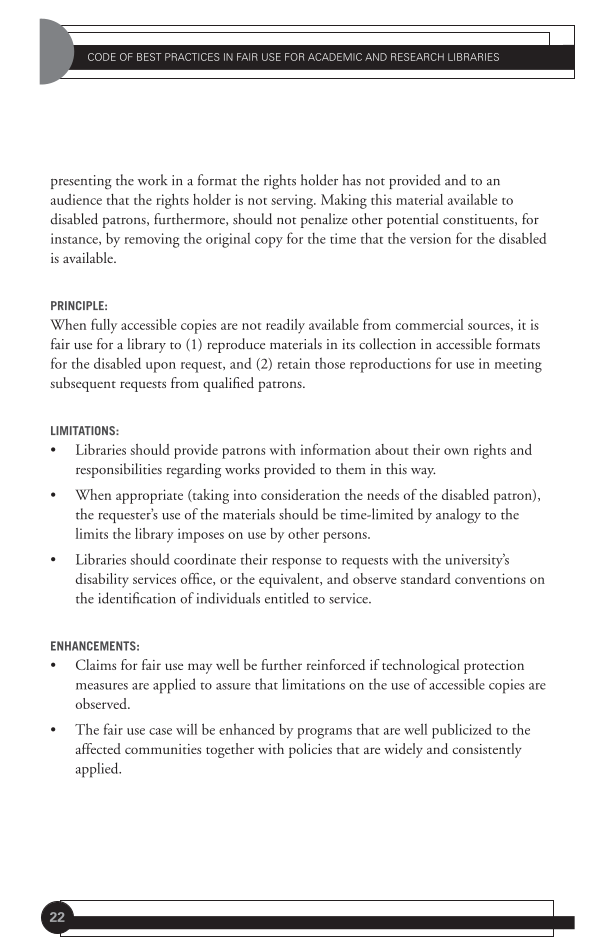CODE OF BEST PRACTICES IN FAIR USE FOR ACADEMIC AND RESEARCH LIBRARIES
22
presenting the work in a format the rights holder has not provided and to an
audience that the rights holder is not serving. Making this material available to
disabled patrons, furthermore, should not penalize other potential constituents, for
instance, by removing the original copy for the time that the version for the disabled
is available.
PRINCIPLE:
When fully accessible copies are not readily available from commercial sources, it is
fair use for a library to (1) reproduce materials in its collection in accessible formats
for the disabled upon request, and (2) retain those reproductions for use in meeting
subsequent requests from qualified patrons.
LIMITATIONS:
• Libraries should provide patrons with information about their own rights and
responsibilities regarding works provided to them in this way.
• When appropriate (taking into consideration the needs of the disabled patron),
the requester’s use of the materials should be time-limited by analogy to the
limits the library imposes on use by other persons.
• Libraries should coordinate their response to requests with the university’s
disability services office, or the equivalent, and observe standard conventions on
the identification of individuals entitled to service.
ENHANCEMENTS:
• Claims for fair use may well be further reinforced if technological protection
measures are applied to assure that limitations on the use of accessible copies are
observed.
• The fair use case will be enhanced by programs that are well publicized to the
affected communities together with policies that are widely and consistently
applied.
22
presenting the work in a format the rights holder has not provided and to an
audience that the rights holder is not serving. Making this material available to
disabled patrons, furthermore, should not penalize other potential constituents, for
instance, by removing the original copy for the time that the version for the disabled
is available.
PRINCIPLE:
When fully accessible copies are not readily available from commercial sources, it is
fair use for a library to (1) reproduce materials in its collection in accessible formats
for the disabled upon request, and (2) retain those reproductions for use in meeting
subsequent requests from qualified patrons.
LIMITATIONS:
• Libraries should provide patrons with information about their own rights and
responsibilities regarding works provided to them in this way.
• When appropriate (taking into consideration the needs of the disabled patron),
the requester’s use of the materials should be time-limited by analogy to the
limits the library imposes on use by other persons.
• Libraries should coordinate their response to requests with the university’s
disability services office, or the equivalent, and observe standard conventions on
the identification of individuals entitled to service.
ENHANCEMENTS:
• Claims for fair use may well be further reinforced if technological protection
measures are applied to assure that limitations on the use of accessible copies are
observed.
• The fair use case will be enhanced by programs that are well publicized to the
affected communities together with policies that are widely and consistently
applied.


































